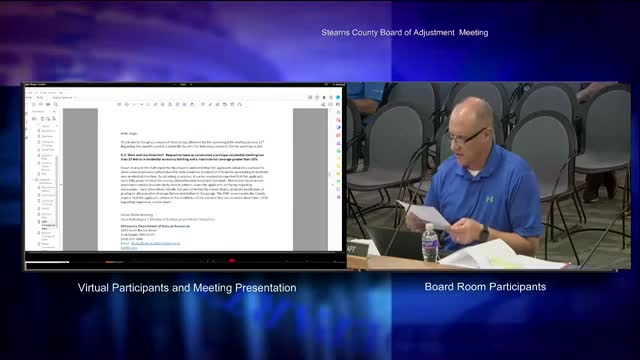Stormwater Management Sparks Controversy Over Property Variance
June 14, 2024 | Stearns County, Minnesota

This article was created by AI summarizing key points discussed. AI makes mistakes, so for full details and context, please refer to the video of the full meeting. Please report any errors so we can fix them. Report an error »

In a recent government meeting, discussions centered around a variance request related to stormwater management and impervious surface coverage for a residential property. The Minnesota Department of Natural Resources (DNR) recommended that the county enforce conditions from a previously issued variance in November 2020, which addressed concerns about impervious surfaces.
The applicants, who had made significant modifications to their property, expressed their commitment to compliance and shared their experiences with stormwater drainage issues. They detailed how their engineered stormwater management system functioned well during normal rainfall but struggled during heavy storms, leading to water pooling around their home. They implemented changes, including adjusting the driveway's pitch to direct water away from the house, which they claimed resolved the issue.
Despite these efforts, concerns were raised about the overall impervious surface coverage, which reportedly exceeded the state guideline of 25%. The applicants argued that their previous cabin had similar coverage and that they had made improvements to the property, including moving the new structure further from the lake.
The board deliberated on whether to treat the variance request as an amendment to the existing variance or as a new request. Ultimately, they acknowledged the complexities of the situation, including the impact of neighboring properties on drainage issues. A representative from Millwood Township also addressed concerns from a neighboring property owner regarding water drainage, indicating that the township had limited resources to address such issues.
After extensive discussion, the board voted to approve the variance request, allowing for a maximum lot coverage of 36.7%. The decision was based on the applicants' good faith efforts to comply with regulations and the understanding that the drainage issues were exacerbated by external factors beyond their control. The meeting highlighted the ongoing challenges of managing stormwater in residential areas, particularly in light of changing weather patterns and increased impervious surfaces.
The applicants, who had made significant modifications to their property, expressed their commitment to compliance and shared their experiences with stormwater drainage issues. They detailed how their engineered stormwater management system functioned well during normal rainfall but struggled during heavy storms, leading to water pooling around their home. They implemented changes, including adjusting the driveway's pitch to direct water away from the house, which they claimed resolved the issue.
Despite these efforts, concerns were raised about the overall impervious surface coverage, which reportedly exceeded the state guideline of 25%. The applicants argued that their previous cabin had similar coverage and that they had made improvements to the property, including moving the new structure further from the lake.
The board deliberated on whether to treat the variance request as an amendment to the existing variance or as a new request. Ultimately, they acknowledged the complexities of the situation, including the impact of neighboring properties on drainage issues. A representative from Millwood Township also addressed concerns from a neighboring property owner regarding water drainage, indicating that the township had limited resources to address such issues.
After extensive discussion, the board voted to approve the variance request, allowing for a maximum lot coverage of 36.7%. The decision was based on the applicants' good faith efforts to comply with regulations and the understanding that the drainage issues were exacerbated by external factors beyond their control. The meeting highlighted the ongoing challenges of managing stormwater in residential areas, particularly in light of changing weather patterns and increased impervious surfaces.
View full meeting
This article is based on a recent meeting—watch the full video and explore the complete transcript for deeper insights into the discussion.
View full meeting
